Summary November marked the onset of the short rains in northern Kenya after a prolonged dry spell
Summary
November marked the onset of the short rains in northern Kenya after a prolonged dry spell. This came as a relief for many animals which previously had to trek long distances to find water and pasture, also increasing the chances of human wildlife conflict associated injuries.
Despite this there were few cases of wildlife injuries. Many other cases may not have been reported due to heavy rains and debilitated roads in wildlife conservation areas.
A cheetah in Samburu reserve suffered a tear on the calcaneal tendon which needed urgent repair. This animal was captured and transported to Nairobi for treatment. A white rhino in Meru national park which suffered cutaneous filariasis was captured and treated. It is reported to have improved tremendously after treatment.
We conducted a post mortem examination on a male white rhino carcass in Solio ranch which is thought to have died from injuries sustained during a fight. An elephant which had been translocated from Ol Pejeta conservancy in June also died from natural causes in Meru national park. Other clinical cases and disease investigation are discussed in the report.
We would like to acknowledge the support of the DSWT in providing funding and logistical support to the veterinary unit in northern Kenya. This has enabled the unit to relief suffering and save the lives of many animals in the northern region.
- Injured cheetah in Samburu national reserve
Introduction
A male, adult cheetah was reported to have shown severe lameness on the hind limb for one month, limited movement and was unable to hunt on its own. The naturalist at Samburu lodge which provided meat to sustain the animal requested for veterinary evaluation.
The animal had been treated 3 weeks prior by Dr. Mutinda but no improvement was noted hence it was decided to capture the animal for re- examination and confinement.
We immobilized the cheetah on 9th November 2013.
A combination of 5% Ketamine HCl 50mg and 0.1% Medetomidine HCl 0.7mg in a 1.5cc DanInject dart and 1.5×25mm needle was used. The dart was placed into the left gluteal muscles. Induction time was 5 minutes.
Atipamezole HCl 5mg was administered intramuscularly 1 hour after the initial dose to reverse the effect of Medetomidine.
Findings and management
- The cheetah was in poor body condition; 2 ( on a scale 1 – 5)
- Hyperflexion of the left hock joint and rupture on the calcaneal tendon
- Manipulation revealed hock joint sub-luxation
These injuries may have been caused by trauma on the hock joint during flight.
Non steroidal anti – inflammatory drugs for pain management and multi vitamin formulation were administered.
The animal was transported in a standard animal cage to Nairobi for radiography and confinement for further management of the injuries.
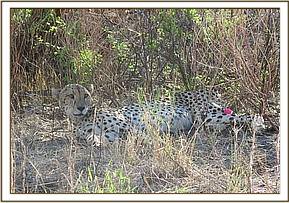

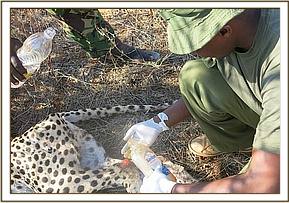


- Cutaneous filariasis in a white rhino in Meru national park
Introduction
The rhino monitoring team in Meru National Park reported on 5th November that a female white rhino known as Rossie had cutaneous wounds which required veterinary attention. After two weeks of close monitoring the wounds seemed to have grown bigger and because she had an 18 month old calf we requested for a KWS helicopter to assist in immobilization and monitoring the calf after immobilization.
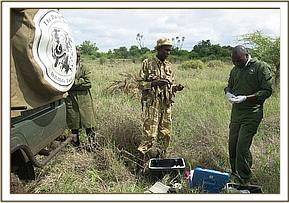

Chemical immobilization
We used a combination of Etorphine Hcl (M99®) 5mg and Xylazine Hcl 80mg in a 1.5ml Dan Inject dart with a 2.2 × 60mm needle. Darting was conducted from a helicopter.
The dart was placed into the left gluteal muscles. Induction time was 5 minutes and the calf was chased away by a vehicle.
On contact with the animal, copious amount of water was doused to cool the animal. Opticlox ointment was applied on the dart wound and eyes to prevent desiccation of the cornea. Vital parameters such as respiration and tissue perfusion were continuously monitored to ensure that the narcotized animal was stable.
After the procedure, Naltrexone ® 150mg and Atipamezole 10mg were administered intravenously into the superficial ear veins to reverse the effects of the opioid and the α-2 adrenoceptor agonist. Naltrexone HCl 75mg was also administered intramuscularly to prevent renarcotization.
She re – united with its calf soon after she woke up from anesthesia.
Physical examination and diagnosis
There was an expansive wound ventrally on the right abdominal flank about 20 cm × 10 cm in diameter. The lesion which was superficial on the skin extending to the subcutis was characterized by redness, erosive ulceration and crust formation. The edges of the lesion were serrated, necrotized and the skin around it undermined with pockets of blood.
These observations are characteristic of cutaneous filariasis thought to be caused by Stephanofiria dinniki in white rhino. The wounds are exacerbated ox pecker birds and bacterial infection.
Prognosis for recovery is good, wounds respond well to treatment.
Treatment
- Thorough wash with water, dilute hydrogen peroxide and debridement of necrotic tissue.
- Tincture of Iodine soaked in gauze swabs was the applied
- 1% Ivermectin 300mg administered subcutaneously
- 30% Oxytetracycline 30000mg administered intramuscularly
- Green clay was applied to prevent fly infestation to aid in healing
Notable improvement was noted after 7 days of monitoring this animal.

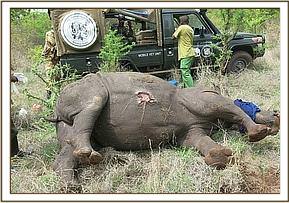

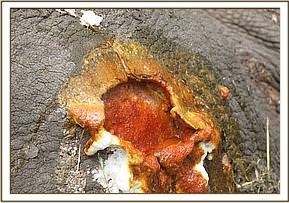

- Post mortem examination of a white rhino carcass in Solio ranch
An adult male white rhino which was reported to have been sickly for 6 months died in Solio ranch on 21st November 2013. Prior to death the animal showed lameness on the right forelimb. The ranch management requested for a post mortem to determine the cause of death.
Significant findings
- Both horns were retrieved and kept by the Senior Warden at Aberdare national park.
- The carcass had partly been scavenged by lions with the brisket and right forelimb consumed
- The animal showed poor general body condition.
- On opening the carcass, the 5th and 6th rib on the right side were fractured with scar tissue formation
- Hemorrhages in the apical lobe of the right lung
- Other internal organs were normal
This animal is suspected to have died from thoracic trauma which may explain the lameness and deteriorating body condition with no visible injury externally. These injuries may be attributed to territorial fights which are not uncommon among male white rhinos.
- Post mortem examination of an elephant in Meru national park
This was an adult male elephant known as Ishmael which had been translocated from Ol Pejeta conservancy in June. The animal had been collared and was suspected to have died on 11th November when signals no movement was seen for 7 days. The carcass was located using GPS coordinates obtained from the collar.
Both tusks were intact. The carcass was extensively decomposed therefore a post mortem examination was not possible. Its death was attributed to natural causes.


- Disease investigation
- On 1st November Mwea national reserve reported that 4 bush bucks had died on various dates at the Thiba river circuit. We visited the reserve on 6th November on a fact finding assignment to establish the cause of death.
Of the 4 bush bucks that died, there was 1 adult male and 3 juveniles in a muddy river bed. One dik dik carcass was also found. The carcasses were extensively decomposed so no post mortem was performed. No active cases were observed during the visit.
In September/ October 3 baboons and 1 common zebra carcasses were found during routine patrols.
Cause of death:
- Weak animals got stuck in the mud. The river banks seemed to recede when flow gates from nearby hydroelectric dams were opened at the beginning of the short rains season. This left a muddy river bed exposing animals to danger.
- Anthrax: Mwea reserve has been a foci of B. anthracis outbreaks in giraffes and hippos previously, further investigation and laboratory analysis of samples is recommended to rule out the disease.
We recommend proper disposal of carcasses through burning and/or burying. In addition the reserve should report suspected sick animals to collect samples for confirmatory diagnosis.
- Three buffalos were reported dead at a swamp in Meru national park. The deaths coincided with the onset of short rains in November. Possible cause of death was exposure to lush grass which may predispose weak animals after a prolonged dry spell to bloating.